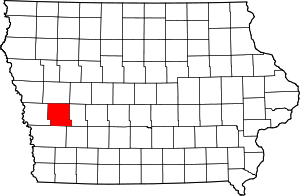St. Boniface Catholic Church (Westphalia, Iowa)
|
Saint Boniface Catholic Church District | |
  | |
| Location | Three blocks north of County Road F32, Westphalia, Iowa |
|---|---|
| Coordinates | 41°43′17″N 95°23′44″W / 41.72139°N 95.39556°WCoordinates: 41°43′17″N 95°23′44″W / 41.72139°N 95.39556°W |
| Area | 13.1 acres (5.3 ha) |
| Built | 1882 |
| Architect |
Fridolin Heer (church) Creeglon and Berlinghof (rectory) Lahr and Stangel (school) |
| Architectural style | Romanesque Revival |
| MPS | Ethnic Historic Settlement of Shelby and Audubon Counties MPS |
| NRHP Reference # | 91001449[1] |
| Added to NRHP | October 3, 1991 |
St. Boniface Catholic Church is a parish of the Diocese of Des Moines. The church is located in Westphalia, Iowa, United States, and the parish plant is listed on the National Register of Historic Places as Saint Boniface Catholic Church District. At the time of its nomination the district consisted of 16 resources, including six contributing buildings, one contributing structure, two contributing sites, one contributing object, six noncontributing buildings, and one noncontributing object.[2]
History
The area that is now Westphalia was settled by German Catholics in the 1870s. The community’s founder, Herman Schwarte, envisioned a peaceful village where Germans could work the land, be self-sufficient and help one another. The community would be centered on their own church. The Emil Flusche home was the location of the first Catholic Mass. He was the land agent for the railroad who encouraged German Catholics to settle here and helped establish a Catholic church in this community. Bishop John Hennessy of the Diocese of Dubuque bought the property and established the parish in 1873. The cemetery was laid out the following year. In 1881 the parish became a part of the Diocese of Davenport when it was established. Father Weber was pastor when the church was built. Bishop John McMullen of Davenport dedicated it in 1882. The rectory (1888) and the carriage house/ barn were built during the pastorate of Msgr. Brommenschenkel. The parish became part of the Diocese of Des Moines when it was established in 1911. It was incorporated the following year. The Rev. Hubert Duren became pastor in 1926 after a period of decline for the town. He is credited with its rebirth through his Complete Life Program.[2] It was during his 36-year pastorate that the parochial school (1927), ball diamond (c. 1927), Shrine of Our Lady of Grace (1930), corn crib (First Fruits; 1933), and the club house (1934) were built.
Architecture
St. Boniface Church was designed by Dubuque architect Fridolin Heer in the Romanesque Revival style. The workers baked their own bricks on site to build the church. It follows a rectangular plan and features a central bell tower capped with a spire, and three entry doors across the main facade. It and the rectory were covered with stucco in 1919. The rectory is a two-story brick residence capped with a truncated hipped roof. It was designed by the Omaha architectural firm of Creeglon and Berlinghof. The school building is a 2½ brick structure designed by Lahr and Stangel of Omaha. It features a monumental stone veneered central entry. The cemetery is notable for a significant number of cast iron and hand-wrought iron crosses for grave markers.[2] There is also a frame, Romanesque Revival, Chapel of St. Joseph located near the cemetery gate.
References
- ↑ National Park Service (2010-07-09). "National Register Information System". National Register of Historic Places. National Park Service.
- 1 2 3 Leah Rogers. "Saint Boniface Catholic Church District" (PDF). National Park Service. Retrieved 2016-06-05. with 21 photos from c. 1991

